Midterm Project: Report
Interaction Lab section 4 – Gottfried Haider
Yoon Lee
The Battlefield
In the earlier semester, we went through several steps of research. These research activities provided the idea of developing my personal concept of interaction. Especially while working on the research response on interactive art projects, it made me think deeply about the major factors of interactive design. I remember that the impact of “The Augmented Reality Sandbox” had a significant role in defining interaction, which led to the conclusion that the subject should not be performing alone. The performance of the subject should appear after or while the interaction is being made. Moreover, after a few weeks of a group research project, I was able to approach more deeply into what it is to perform interactivity. This also played a crucial role in designing my own project for interactivity performance.
Our midterm project was to create a battlefield. The main focus of this project was to build an Arduino – powered catapult. Despite there are various ways of designing a catapult, we had to find a unique mechanism that would function with the limited power of servo motors. Once we designed the catapult, the question was “what to do with the catapult?”. The idea of the Arduino catapult came from my childhood memory of building a wooden catapult. However, every time I made a catapult, the method of playing with the catapult always ended up just shooting the objects. In order to develop the catapult as a game, we made a separate cardboard design of the battlefield with two different targets. Once the object successfully hits the target (basket) without any disturbance by the obstacles (trees, soldiers), the LED light above the target glows. Children could now play with the catapult in more diverse and competitive ways, with a very noticeable display.
Unlike many other teams, we designed two different parts that operated separately. We had to provide a clear viewpoint of operating the project just by observing the exterior. To do so, we conducted our project in a very straightforward design. In the beginning, we considered other various actuators to trigger the catapult. But we thought those actuators could cause a few problems regarding the launching process. For example, the ultrasonic sensor was difficult to figure out whether the catapult was triggered since the sensor occasionally fails to detect the range. Additionally, the sensor could automatically trigger the catapult when someone just walks past by the catapult. In order to prevent the unintentional launch and make the process less confusing, we chose the most conventional actuator which was a button. Secondly, we designed the target like a basket. While building a cardboard battlefield, we spent a lot of time worrying about the target. Since the ultimate purpose of our project was to hit the target, we wanted an impact so that users could feel a certain accomplishment. We first thought the target would look like a circular one with a bull’s-eye in the center. Unfortunately, it seemed like it was not only hard to define whether it struck or not when the object strikes the edge, but also had a less impact since the object bounces off of the target. We also realized that some people could misunderstand the soldier as a target if the target is not distinctly noticeable. Due to several concerns, we got the idea from a basketball ring and made a basket as a target so that the target is straightforward. Once the object went inside the basket, all the concerns of the target were solved. We further developed our target with a light sensor inside the baskets to aim our goal. Once the object went inside, it blocked the light sensor from the light, which triggered the LED lights above the basket to glow and show who won the game.
When we started on the project, we had two different proposals. My partner suggested a lamp which activates once the movement is detected by the ultrasonic sensor, whereas I suggested a shooting game using an Arduino-powered catapult. After several conversations, we decided on the catapult for our project. As mentioned before, there are numerous ways to design a catapult.
Credits: https://www.youtube.com/watch?v=YX0409FM3Yw
Youtube – hackerspace trento
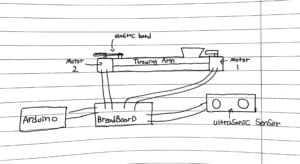
While researching for the design of the catapult, I decided to build a catapult unlike the conventional way in which the elastic tension is created by pulling down the throwing arm. Instead, the throwing arm is located at the base from the first place. While the throwing arm is fixed in the base by the motor 1 (propeller), the second motor on the opposite side pulls the rubber band which is attached to the pivot point. This would create the tension and enable the throwing arm to operate as a lever. Once the motor 1 releases the throwing arm by removing the propeller to the opposite direction, the catapult swings its arm and shoots the object. The throwing arm will return to its original position once the propeller from the second motor returns. Then, the first motor will re-lock the throwing arm and the process could be repeated.
However, there were a lot of limitations while conducting since the main materials we utilized were cardboard and servo motors. Both servo motors and cardboard-made throwing arm couldn’t withstand the tight elasticity of the thick rubber band. The motor couldn’t pull the tight rubber band when the throwing arm was fixed on the other side. Once we changed the rubber band into a thinner one, both the cardboard pillar and throwing arm (including the cardboard-made torque) itself couldn’t withstand the elasticity and ended up being bent. So I worked on redesigning the throwing arm, pillar and the torque. The only material available that came to my mind was screws and nuts. First, I removed the cardboard-made torque and replaced a long screw as a new torque. Then I winded the cardboard-made throwing arm with 3M tape so that it could be solid enough to withstand the elasticity. The final step was to build new pillars. I glued several nuts to build a thick and steady cylindrical pillar. When it seemed everything was on track, the adhesion between the nuts were not strong enough. One side of the pillar broke apart. I thought we needed stronger adhesion rather than glue gun. So I thought soldering the nuts would enable the pillar to withstand the tension. After slight additional repairs to the catapult (attaching a wooden board as a basement), the catapult was good to go.
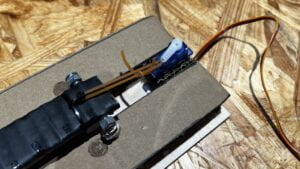
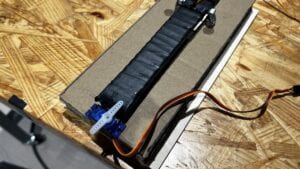
As soon as we finished conducting the catapult, the next day was the User Testing Session. Our goal during user testing was to successfully activate the catapult. Since I was very sick and couldn’t actively participate in the session, Yuni had to finish the Arduino sketch of the catapult. It was very tricky work because we had to make two servo motors activate simultaneously with adequate amount of delay and order. Yuni told me that the sketch was initially twisted which pulled the throwing arm even before it was fixed by the other servo motor. Fortunately, she was able to finish the sketch with the help from the fellows. After I joined the following process, she explained to me about the catapult sketch.
The following step was designing a cardboard battlefield. I suggested the idea of a guard post where I used to serve during my 2 years in the army. We made two different guard posts, each facing the same direction. It was originally facing each other but we changed our plan in order to make the game like a basketball game in the arcade. With the cardboard fence between them, we had one target each with the light sensors (at this point, the shape of the target was not decided) in the guard posts. Yuni suggested that it would be a more interesting game for the users if the battlefield has obstacles which disturbs users to strike a target. I agreed and decorated the battlefield with several obstacles including rocks, soldiers and trees.
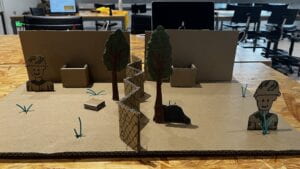
Until the performance day, we still couldn’t decide which shape our target should look like. We had a general idea that the target would look like a basket since we decided a light sensor to be a trigger to light up the LED light. However, it was very difficult to choose the size of the shooting object and the size of the basket since the light sensor did not detect whether the object went in or not. As mentioned above, since the light sensor only activates by the shadows and light, we had to measure the very accurate size of both the shooting object and the basket to ensure it does not cause any confusion. For example, even if the object went in the basket, the LED lights could not glow even if there was light coming into the basket through a small gap. On the other hand, the LED lights could glow even if the object did not go in but landed on the edge of the basket, which provided just enough shadow to activate the light sensor. After several tests before the class time, I managed to make an adequate size for both of them.
Light sensor sketch
const int lightPin = A0; // Pin connected to the light sensor
const int ledPin = 9; // Pin connected to the LED
const int threshold = 500; // Threshold value for the light sensor
void setup() {
pinMode(lightPin, INPUT);
pinMode(ledPin, OUTPUT);
}
void loop() {
// Read the value from the light sensor
int lightValue = analogRead(lightPin);
// If the light level is below the threshold, turn on the LED
if (lightValue < threshold) {
digitalWrite(ledPin, HIGH);
} else {
digitalWrite(ledPin, LOW);
}
}
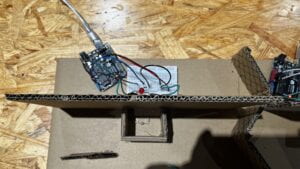
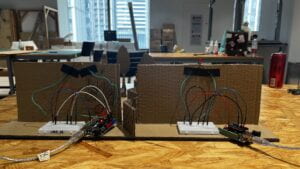
Yoon – Catapult proposal, Catapult design, Catapult construction (torque, pillars, throwing arm), Battlefield design, Battlefield construction, Target construction, Light sensor coding
Yuni – Catapult construction (cardboard work), Catapult coding, Battlefield construction, Battlefield decoration (trees, soldiers)
Our goal of the midterm project was to conduct an interactive game which performers and the subject could collaboratively participate in. My original definition of interaction mainly focused on the process of the interaction. I prioritized making a project where the interaction is formed while the performer is taking action into the subject. I think the project results are well aligned with my definition of interaction. Both battlefield and the catapult operated as an interactive game mechanism once the user (performer) took action into the materials. None of the pieces were not complete nor performed anything if the user wasn’t participating.
On the performance day, the first reaction of the audience went well as we intended. The exterior of the project was concise and straightforward enough to inform the audience that they had to shoot an object with the catapult, and to make the object go into the basket. On the other hand, we also received several constructive feedback from participants and professors. First, since the range of the catapult was short, users had to move the catapult side by side for two different targets. During this process, it was very difficult to move the position of the catapult since the length of the wires between the catapult and the breadboard was too short. Secondly, users had hard time finding the trigger (button) of the catapult since the trigger was attached to the breadboard, not to the catapult itself. Unorganized wire work made it even more difficult for the users to press the trigger.
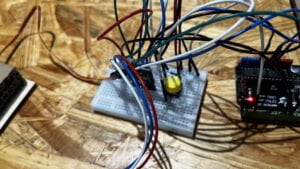
Overall, I believe that the battlefield and especially catapult was very successful. Audience was interested in our project and enjoyed the idea of a shooting game. I think one of the significant reasons that it was receiving many positive comments was because it was unique. We designed a game mechanism which no other teams challenged. However, it was also a great opportunity to receive feedback and critics for further improvements on understanding/performing interaction. If we had more time to work on the project, I would have worked more on surrounding details of the battlefield to make the game even more sophisticated. For example, I would have made the target display the visual number signs along with the LED lights. Additionally, I would have attached a buzzer to each obstacle so that it could make a sound when the object was denied by them. It would have also made the game more interesting if the users had to give up one turn every time they hear a sound from the buzzer.
The most important thing I learnt from this project was that the idea of interaction never requires conventional and stereotyped ways. Most importantly, it is never wrong to try new things. While the entire process and performances from other teams, I felt I was always thinking in stereotyped ways. Although I am proud of my performance, I still chose to replicate the material and idea that already widely existed. Even during the production step, I unconsciously chose methods that were considered to be most safe and reasonable. On performance day, I was truly impressed by innovativeness and creativity from the classmates. It was also crucial to learn that it is very important to go through a well-prepared designing session since we wasted a lot of time redesigning the cardboard materials due to unbalanced size and lengths.